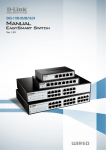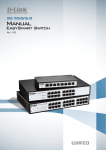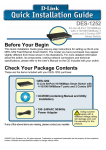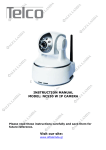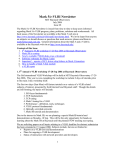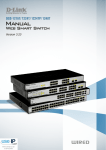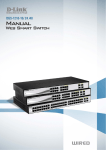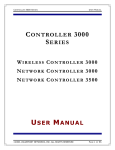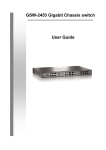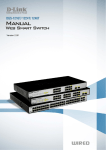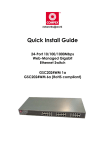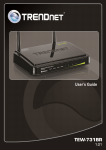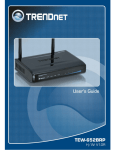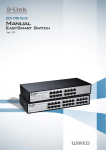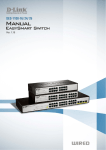Download D-Link DGS-1100-08P network switch
Transcript
D-Link EasySmart Switch User Manual Table of Contents Table of Contents ............................................................................................................................................. i About This Guide ............................................................................................................................................. 1 Terms/Usage .................................................................................................................................................. 1 Copyright and Trademarks ............................................................................................................................ 1 1 Product Introduction ................................................................................................................................... 2 DGS-1100-05 ................................................................................................................................................. 2 Front Panel ................................................................................................................................................. 2 Rear Panel .................................................................................................................................................. 2 DGS-1100-08 ................................................................................................................................................. 2 Front Panel ................................................................................................................................................. 3 Rear Panel .................................................................................................................................................. 3 DGS-1100-08P ............................................................................................................................................... 3 Front Panel ................................................................................................................................................. 3 Rear Panel .................................................................................................................................................. 4 DGS-1100-16 ................................................................................................................................................. 4 Front Panel ................................................................................................................................................. 4 Rear Panel .................................................................................................................................................. 5 DGS-1100-24 ................................................................................................................................................. 5 Front Panel ................................................................................................................................................. 5 Rear Panel .................................................................................................................................................. 5 2 Hardware Installation .................................................................................................................................. 6 Step 1: Unpacking .......................................................................................................................................... 6 Packing contents of DGS-1100-05/08 ........................................................................................................ 6 Packing contents of DGS-1100-08P .......................................................................................................... 6 Packing contents of DGS-1100-16/24 ........................................................................................................ 6 Step 2: Switch Installation .............................................................................................................................. 6 Desktop or Shelf Installation ....................................................................................................................... 6 Rack Installation ......................................................................................................................................... 7 Wall-mount ................................................................................................................................................. 8 Step 3 – Plugging in the AC Power Cord ..................................................................................................... 8 Power Failure ............................................................................................................................................. 9 Grounding the Switch ................................................................................................................................. 9 3 Getting Started ........................................................................................................................................... 10 Management Options ................................................................................................................................... 10 Using Web-based Management .................................................................................................................. 10 Supported Web Browsers ........................................................................................................................ 10 Connecting to the Switch .......................................................................................................................... 10 Login Web-based Management ............................................................................................................... 11 SmartConsole Utility..................................................................................................................................... 11 4 SmartConsole Utility ................................................................................................................................. 13 SmartConsole Settings ................................................................................................................................ 13 Utility Settings ........................................................................................................................................... 13 Log ............................................................................................................................................................ 14 Trap .......................................................................................................................................................... 14 Monitor List ............................................................................................................................................... 15 About ........................................................................................................................................................ 15 Device Configuration .................................................................................................................................... 15 i D-Link EasySmart Switch User Manual Add (+), Delete (-) and Discover the device ............................................................................................. 17 Device List .................................................................................................................................................... 18 5 Configuration ............................................................................................................................................. 19 Web-based Management ............................................................................................................................. 19 Tool Bar > Save Menu ................................................................................................................................. 20 Save Configuration ................................................................................................................................... 20 Tool Bar > Tool Menu .................................................................................................................................. 20 Reboot Device .......................................................................................................................................... 20 Reset System ........................................................................................................................................... 20 Firmware Backup & Upgrade ................................................................................................................... 20 Configuration Backup & Restore .............................................................................................................. 21 Function Tree ............................................................................................................................................... 22 Device Information.................................................................................................................................... 22 System > System Settings ....................................................................................................................... 23 System > Port Settings ............................................................................................................................. 24 System > Trap Settings for SmartConsole ............................................................................................... 24 System > Password Access Control ........................................................................................................ 25 L2 Features > Jumbo Frame .................................................................................................................... 25 L2 Features > Port Trunking..................................................................................................................... 25 L2 Features > IGMP Snooping ................................................................................................................. 26 L2 Features > Port Mirroring .................................................................................................................... 26 L2 Features > Loopback Detection .......................................................................................................... 27 L2 Features > Statistics ............................................................................................................................ 27 L2 Features > Cable Diagnostics ............................................................................................................. 28 VLAN > 802.1Q VLAN .............................................................................................................................. 29 VLAN > 802.1Q Management VLAN ........................................................................................................ 30 VLAN > Port-Base VLAN.......................................................................................................................... 31 VLAN > Surveillance VLAN ...................................................................................................................... 31 VLAN > Voice VLAN ................................................................................................................................. 33 VLAN > Traffic Segmentation ................................................................................................................... 33 QoS > 802.1p Default Priority................................................................................................................... 34 QoS > Storm Control ................................................................................................................................ 34 QoS > Bandwidth Control ......................................................................................................................... 35 Security > MAC Address Table > Static MAC .......................................................................................... 35 Security > MAC Address Table > Dynamic Forwarding Table ................................................................. 36 PoE > PoE Global Settings (DGS-1100-08P only) .................................................................................. 37 PoE > PoE Port Settings (DGS-1100-08P only) ...................................................................................... 38 Appendix A - Ethernet Technology.............................................................................................................. 40 Gigabit Ethernet Technology ....................................................................................................................... 40 Fast Ethernet Technology ............................................................................................................................ 40 Switching Technology .................................................................................................................................. 40 Appendix B - Technical Specifications ....................................................................................................... 41 Hardware Specifications .............................................................................................................................. 41 Key Components / Performance .............................................................................................................. 41 Port Functions .......................................................................................................................................... 41 Physical & Environment ........................................................................................................................... 41 Emission (EMI) Certifications ................................................................................................................... 41 Safety Certifications.................................................................................................................................. 41 Features ....................................................................................................................................................... 41 ii D-Link Web Smart Switch User Manual L2 Features .............................................................................................................................................. 41 VLAN ........................................................................................................................................................ 41 QoS (Quality of Service) ........................................................................................................................... 41 Management............................................................................................................................................. 41 Power Saving ........................................................................................................................................... 41 Appendix C – Rack mount Instructions ..................................................................................................... 42 iii D-Link EasySmart Switch User Manual About This Guide This guide provides instructions to install the D-Link Gigabit Ethernet EasySmart Switch DGS-110005/08/08P/16/24, how to use the Web Utility, and to configure Web-based Management step-by-step. Note: The model you have purchased may appear slightly different from the illustrations shown in the document. Refer to the Product Instruction and Technical Specification sections for detailed information about your switch, its components, network connections, and technical specifications. This guide is mainly divided into four parts: 1. Hardware Installation: Step-by-step hardware installation procedures. 2. Getting Started: A startup guide for basic switch installation and settings. 3. Smart Console Utility: An introduction to the central management system. 4. Configuration: Information about the function descriptions and configuration settings. Terms/Usage In this guide, the term “Switch” (first letter capitalized) refers to the EasySmart Switch, and “switch” (first letter lower case) refers to other Ethernet switches. Some technologies refer to terms “switch”, “bridge” and “switching hubs” interchangeably, and both are commonly accepted for Ethernet switches. A NOTE indicates important information that helps a better use of the device. A CAUTION indicates potential property damage or personal injury. Copyright and Trademarks Information in this document is subjected to change without notice. © 2013 D-Link Corporation. All rights reserved. Reproduction in any manner whatsoever without the written permission of D-Link Corporation is strictly forbidden. Trademarks used in this text: D-Link and the D-LINK logo are trademarks of D-Link Corporation; Microsoft and Windows are registered trademarks of Microsoft Corporation. Other trademarks and trade names may be used in this document to refer to either the entities claiming the marks and names or their products. D-Link Corporation disclaims any proprietary interest in trademarks and trade names other than its own. 1 D-Link EasySmart Switch User Manual 1 Product Introduction Thank you and congratulations on your purchase of D-Link EasySmart Switch Products. D-Link's next generation EasySmart Ethernet switch series blends plug-and-play simplicity with exceptional value and reliability for small and medium-sized business (SMB) networking. All models are housed in a new style rack-mount metal case with easy-to-view front panel diagnostic LEDs. The brand-new DGS-1100 series are born to be green by design of IEEE 802.3az Energy Efficient Ethernet compliant (abbreviated as EEE) and D-Link Green Technologies. It allows significant power saving during periods of low data activity. In most of use cases and environments, switches are idle in 90% or more of time. While no traffic in a short period of time, ports on DGS-1100 switch get into power saving mode automatically. Once if a packet is received, the switch wakes and works immediately. Connecting to EEE compliant devices, such as PCs and servers, the network can save energy without compromising any performance. While connecting to legacy devices which do not support IEEE 802.3az, D-Link Green Technologies can reduce power consumption by detecting short cable and link-down devices. DGS-1100-05 5-Port 10/100/1000Mpbs EasySmart Switch Front Panel Figure 1– DGS-1100-05 Front Panel Power LED: The Power LED lights up when the Switch is connected to a power source. Link/Act/Speed LED (Ports 1-5): Flashing: Indicates a network link through the corresponding port. Blinking: Indicates that the Switch is either sending or receiving data to the port. Green: Indicates that the port is running at 1000M. Amber: Indicates that the port is running at 10/100M. Light off: No link. Reset: By pressing the Reset button for 5 seconds the Switch will change back to the default configuration and all changes will be lost. Rear Panel Figure 2– DGS-1100-05 Rear Panel 5V/1A AC adapter: The port is where to connect the 5V/1A AC adapter. DGS-1100-08 8-Port 10/100/1000Mpbs EasySmart Switch 2 D-Link EasySmart Switch User Manual Front Panel Figure 3 – DGS-1100-08 Front Panel Power LED: The Power LED lights up when the Switch is connected to a power source. Link/Act/Speed LED (Ports 1-8): Flashing: Indicates a network link through the corresponding port. Blinking: Indicates that the Switch is either sending or receiving data to the port. Green: Indicates that the port is running at 1000M. Amber: Indicates that the port is running at 10/100M. Light off: No link. Reset: By pressing the Reset button for 5 seconds the Switch will change back to the default configuration and all changes will be lost. Rear Panel Figure 4 – DGS-1100-08 Rear Panel 5V/1A AC adapter: The port is where to connect the 5V/1A AC adapter. DGS-1100-08P 8-Port 10/100/1000Mpbs PoE EasySmart Switch Front Panel Figure 5 – DGS-1100-08P Front Panel Power LED: The Power LED lights up when the Switch is connected to a power source. PoE MAX. LED: Light up: Indicates the power output to PDs is over 57W. No additional PDs can be powered for safety consideration. Blinking: Indicates if the user unplugged certain PDs and made the PoE power budget left over 7W, the PoE MAX LED will blink 2 minutes. Light off: Indicates the power budget is using less than 57W. Link/Act/Speed LED (Ports 1-8): Flashing: Indicates a network link through the corresponding port. 3 D-Link EasySmart Switch User Manual Blinking: Indicates that the Switch is either sending or receiving data to the port. Green: Indicates that the port is running at 1000M. Amber: Indicates that the port is running at 10/100M. Light off: No link. PoE LED (Ports 1-8): Green: Indicates the PoE powered device (PD) is connected and the port supplies power successfully. Red: The PoE port has failed, possibly due to: 1. PoE total power budget shortage 2. Over current: Exceeds the power current of powered device's classification. 3. Short circuit: Short circuit has been performed on a powered device Light off: Indicates no Powered Device (PD) connected. Reset: By pressing the Reset button for 5 seconds the Switch will change back to the default configuration and all changes will be lost. Rear Panel Figure 6 – DGS-1100-08P Rear Panel 48V/1.57A Desktop adapter: The port is where to connect the 48V/1.57A Desktop adapter. DGS-1100-16 16-Port 10/100/1000Mpbs EasySmart Switch Front Panel Figure 7 - DGS-1100-16 Front Panel Power LED: The Power LED lights up when the Switch is connected to a power source. Link/Act/Speed LED (Ports 1-16): Flashing: Indicates a network link through the corresponding port. Blinking: Indicates that the Switch is either sending or receiving data to the port. Green: Indicates that the port is running at 1000M. Amber: Indicates that the port is running at 10/100M. Light off: No link. Reset: By pressing the Reset button for 5 seconds the Switch will change back to the default configuration and all changes will be lost. 4 D-Link EasySmart Switch User Manual Rear Panel Figure 8– DGS-1100-16 Rear Panel Power: The power port is where to connect the AC power cord. DGS-1100-24 24-Port 10/100/1000Mpbs EasySmart Switch Front Panel Figure 9 – DGS-1100-24 Front Panel Power LED: The Power LED lights up when the Switch is connected to a power source. Link/Act/Speed LED (Ports 1-24): Flashing: Indicates a network link through the corresponding port. Blinking: Indicates that the Switch is either sending or receiving data to the port. Green: Indicates that the port is running at 1000M. Amber: Indicates that the port is running at 10/100M. Light off: No link. Reset: Press the reset button for 5 seconds to reset the Switch back to the default settings. All previous changes will be lost. Rear Panel Figure 10– DGS-1100-24 Rear Panel Power: Connect the supplied AC power cable to this port. 5 D-Link EasySmart Switch User Manual 2 Hardware Installation This chapter provides unpacking and installation information for the D-Link EasySmart Switch. Step 1: Unpacking Open the shipping carton and carefully unpack its contents. Please consult the packing list located in the User Manual to make sure all items are present and undamaged. If any item is missing or damaged, please contact your local D-Link reseller for replacement. Packing contents of DGS-1100-05/08 One D-Link EasySmart Switch One AC Power Adapter Four rubber feet One accessory kit for wall-mount installation One ground screw that screw on the D-Link EasySmart Switch One Multi-lingual Getting Started Guide One CD with User Manual and SmartConsole Utility program Packing contents of DGS-1100-08P One D-Link EasySmart Switch One Desktop Power Adapter One AC power cord Four rubber feet One ground screw that screw on the D-Link EasySmart Switch One Multi-lingual Getting Started Guide One CD with User Manual and SmartConsole Utility program Packing contents of DGS-1100-16/24 One D-Link EasySmart Switch One AC power cord Four rubber feet Screws and two mounting brackets One accessory kit for a ground screw One Multi-lingual Getting Started Guide One CD with User Manual and SmartConsole Utility program If any item is found missing or damaged, please contact the local reseller for replacement. Step 2: Switch Installation For safe switch installation and operation, it is recommended that you: Visually inspect the power cord to see that it is secured fully to the AC power connector. Make sure that there is proper heat dissipation and adequate ventilation around the switch. Do not place heavy objects on the switch. Desktop or Shelf Installation When installing the switch on a desktop or shelf, the rubber feet included with the device must be attached on the bottom at each corner of the device’s base. Allow enough ventilation space between the device and the objects around it. 6 D-Link EasySmart Switch User Manual Figure 11 – Attach the adhesive rubber pads to the bottom Rack Installation The switch can be mounted in an EIA standard size 11-inch rack, which can be placed in a wiring closet with other equipment. To install, attach the mounting brackets to the switch’s side panels (one on each side) and secure them with the screws provided (please note that these brackets are not designed for palm size switches). Figure 12 – Attach the mounting brackets to the Switch Then, use the screws provided with the equipment rack to mount the switch in the rack. Figure 13– Mount the Switch in the rack or chassis Please be aware of following safety Instructions when installing: A) Elevated Operating Ambient - If installed in a closed or multi-unit rack assembly, the operating ambient temperature of the rack environment may be greater than room ambient. Therefore, consideration should be given to installing the equipment in an environment compatible with the maximum ambient temperature (Tma) specified by the manufacturer. 7 D-Link EasySmart Switch User Manual B) Reduced Air Flow - Installation of the equipment in a rack should be such that the amount of air flow required for safe operation of the equipment is not compromised. C) Mechanical Loading - Mounting of the equipment in the rack should be such that a hazardous condition is not achieved due to uneven mechanical loading. D) Circuit Overloading - Consideration should be given to the connection of the equipment to the supply circuit and the effect that overloading of the circuits might have on overcurrent protection and supply wiring. Appropriate consideration of equipment nameplate ratings should be used when addressing this concern. E) Reliable Earthing - Reliable earthing of rack-mounted equipment should be maintained. Particular attention should be given to supply connections other than direct connections to the branch circuit (e.g. use of power strips)." Wall-mount The Switch can be mounted on a wall. Two mounting slots are provided on the bottom of the switch for this purpose. Please follow the installation steps to complete wall-mount process. Mounting on a cement wall Step 1: Mount the nylon screw anchors ø5 x 22L mm (included in the accessory kit ) into a cement wall Step 2: Drive the T3 x 15L screws into the nylon screw anchors. Step 3: Hook the mounting holes of the switch back on the screws. Mounting on a wood wall Step 1: Drive the T3 x 15L screws into a wood wall. Step 2. Hook the mounting holes of the switch back on the screws. Figure 14 –Wall mount installation Step 3 – Plugging in the AC Power Cord Users may now connect the AC power cord into the rear of the switch and to an electrical outlet (preferably one that is grounded and surge protected). 8 D-Link EasySmart Switch User Manual Figure 15 –Plugging the switch into an outlet Power Failure As a precaution, the switch should be unplugged in case of power failure. When power is resumed, plug the switch back in. Grounding the Switch This section describes how to connect the EasySmart Switch to ground. You must complete this procedure before powering your switch. Required Tools and Equipment Ground screws (included in the accessory kit): One M4 x 6 mm (metric) pan-head screw Ground cable (not included in the accessory kit): The grounding cable should be sized according to local and national installation requirements. Depending on the power supply and system, a 12 to 6 AWG copper conductor is required for U.S installation. Commercially available 6 AWG wire is recommended. The length of the cable depends on the proximity of the switch to proper grounding facilities. A screwdriver (not included in the accessory kit) The following steps let you connect the switch to a protective ground: Step 1: Verify if the system power is off. Step 2: Use the ground cable to place the #8 terminal lug ring on top of the ground-screw opening, as seen in the figure below. Step 3: Insert the ground screw into the ground-screw opening. Step 4: Using a screwdriver, tighten the ground screw to secure the ground cable to the switch. Step 5: Attach the terminal lug ring at the other end of the grounding cable to an appropriate grounding stud or bolt on rack where the switch is installed. Step 6: Verify if the connections at the ground connector on the switch and the rack are securely attached. Figure 16 –Ground cable, screw and #8 terminal lug rings 9 D-Link EasySmart Switch User Manual 3 Getting Started This chapter introduces the management interface of D-Link EasySmart Switch. Management Options The D-Link EasySmart Switch can be managed through any port on the device by using the Web-based Management or through any PC using the SmartConsole Utility. Each switch must be assigned its own IP Address, which is used for communication with Web-Based Management. The PC’s IP address should be in the same range as the switch. Each switch can allow only one user to access the Web-Based Management at a time. The PC should have an IP address in the same range as the switch. Each switch can allow one user to access to the Web-Based Management at a time. However, if you want to manage multiple D-Link EasySmart Switches, the SmartConsole Utility is a more convenient choice. By using the SmartConsole Utility, you do not need to change the IP address of your PC and it is easier to initialize multiple EasySmart Switches. Please refer to the following installation instructions for the Web-based Management and the SmartConsole Utility. Using Web-based Management After a successful physical installation, you can configure the Switch, monitor the network status, and display statistics using a web browser. Supported Web Browsers The embedded Web-based Management currently supports the following web browsers: Internet Explorer 6 or later version Netscape 8 or later version Firefox 3.0 or later version Chrome 5.0 or later version Safari 4.0 or later version Opera 10 or later version Connecting to the Switch You will need the following equipment to begin the web configuration of your device: 1. A PC with a RJ-45 Ethernet connection 2. A standard Ethernet cable Connect the Ethernet cable to any of the ports on the front panel of the switch and to the Ethernet port on the PC. 10 D-Link EasySmart Switch User Manual Figure 17 –Connected Ethernet cable Login Web-based Management In order to login and configure the switch via an Ethernet connection, the PC must have an IP address in the same subnet as the switch. For example, if the switch has an IP address of 10.90.90.90, the PC should have an IP address of 10.x.y.z (where x/y is a number between 0 ~ 254 and z is a number between 1 ~ 254), and a subnet mask of 255.0.0.0. There are two ways to launch the Web-based Management, you may either click the Web Access button at the top of the SmartConsole Utility or open the web browser and enter 10.90.90.90 (the factory-default IP address) in the address bar. Then press <Enter>. Figure 18 –Enter the IP address 10.90.90.90 in the web browser NOTE: The switch's factory default IP address is 10.90.90.90 with a subnet mask of 255.0.0.0 and a default gateway of 0.0.0.0. The web configuration can also be accessed through the SmartConsole Utility. Open the SmartConsole Utility and double-click the switch as it appears in the Monitor List. This will automatically load the web configuration in your web browser. When the following logon dialog box appears, enter the password then click OK. The default password is admin. Figure 19 – Logon Dialog Box SmartConsole Utility The SmartConsole Utility included in the installation CD is a program for discovering D-Link Smart Switches and EasySmart Switches within the same L2 network segment connected to your PC. This tool is only for computers running Windows 2000, Windows XP, Windows Vista x64/32 or Windows 7 x64/32 operating systems. There are two options for the installation of the SmartConsole Utility; one is through the autorun program on the installation CD and the other is manual installation. 11 D-Link EasySmart Switch User Manual NOTE: Please be sure to uninstall any existing SmartConsole Utility from your PC before installing the latest SmartConsole Utility. Option 1: Follow these steps to install the SmartConsole Utility via the autorun program on the installation CD. 1. Insert the Utility CD into your CD-Rom/DVD-Rom Drive. 2. The autorun program will appear automatically. 3. Click on the ”Install SmartConsole Utility” button and an installation wizard will guide you through the process. 4. After successfully installing the SmartConsole Utility, you can open the utility by clicking Start > Programs > D-Link SmartConsole Utility. 5. Connect the Smart Switch to the same L2 network segment of your PC and use the SmartConsole Utility to discover the Smart Switches. Option 2: Follow these steps to install the SmartConsole Utility manually. 1. Insert the Utility CD into your CD-Rom/DVD-Rom Drive. 2. From the Start menu on the Windows desktop, click Computer. 3. Double click on you CD-Rom/DVD-Rom Drive to start the autorun menu, or right click on the Drive to open the folder. Select SmartConsole Utility and double click on the .exe file. 4. Follow the on-screen instructions to install the utility. 5. Upon completion, go to Start > Programs > D-Link SmartConsole Utility and open the SmartConsole Utility. 6. Connect the Smart Switch to the same L2 network segment of your PC and use the SmartConsole Utility to discover the Smart Switches. For detailed explanations of SmartConsole’s functions, please refer to Chapter 4 SmartConsole Utility 12 D-Link EasySmart Switch User Manual 4 SmartConsole Utility The D-Link SmartConsole Utility allows the administrator to quickly discover all D-Link Smart Switches and EasySmart Switches which are in the same domain of the PC, collect traps and log messages, and quick access to basic configurations of the switch. The SmartConsole Utility consists of three parts, Device Configurations at the top, Device List as the main body, and SmartConsole Settings at the left. Device Configuration SmartConsole Settings Figure 20– SmartConsole Utility Device List SmartConsole Settings The SmartConsole Settings at the left has five icons, Utility Settings, Log, Trap, File, and Help. Utility Settings Click this icon to launch the Utility Settings window. Refresh time refreshes the devices which were selected as monitored device in the Device List. Choices include 15 secs, 30 secs, 1mins, 2mins, and 5 mins for selecting the monitoring time intervals. Utility Group Interval establishes the intervals (in seconds) that the Switch will be discovered in the SmartConsole Device List. Figure 21– SmartConsole Utility Settings 13 D-Link EasySmart Switch User Manual NOTE: If the Group Interval is set to 0, IGMP Snooping must be disabled in the Switch or the switches will not be discovered. Log Click this icon to launch the Log window. Click View Log to show the events of the SmartConsole Utility and the device. Date/Time indicates when the message was received, IP denotes where it comes from and Status shows the content of this log message. Click Clear Log to clear all log entries. Click OK to exit. Figure 22– SmartConsole Log Trap Click this icon to launch the Trap window. Click View Trap to show the events of the SmartConsole Utility and the device. Date/Time indicates when the trap message was received, IP denotes where it comes from and Status shows the content of this trap message. Click Clear Trap to clear all entries. Click OK to exit Figure 53 – SmartConsole Trap The trap icon in the SmartConsole Settings will change while receiving new trap messages. Please see below for detailed description. Icon Description No new traps New traps was received 14 D-Link EasySmart Switch User Manual Monitor List By clicking on this icon you will see below options: Figure 24– SmartConsole Monitor List Monitor Save: Records the setting of the Device List as default for the next time the SmartConsole Utility is used. Monitor Save As: Records the setting of the Device List in an appointed filename and file path. Monitor Load: Manually load a Device List setting file. About Click this icon to launch the SmartConsole Info window. Figure 25– SmartConsole About Device Configuration The Device Configuration in the SmartConsole Utility has five icons: Device Settings Password Manager Firmware Upgrade DHCP Refresh Web Access And the , device buttons for the Device List. Device Settings Select a switch from the Device List. Click on this icon to launch the Device Settings window. Here you can configure the Product Name, IP Address, Gateway, Subnet Mask, System Name, Location, Trap Host IP, and DHCP Client Setting of the Switch. 15 D-Link EasySmart Switch User Manual To apply the configuration, insert the correct device password in the Confirm Password box and then click OK Figure 26 – SmartConsole Device Settings NOTE: The EasySmart Switch automatically sends out discovery packets to maintain the connection between the devices and SmartConsole Utility. Therefore, ensure to configure the Group Interval setting. Password Manager Select a switch from the Device List. Click on this icon to launch the Device Password Manager window. Here you can enter a new password and confirm it. Figure 27– SmartConsole Password Manager Firmware Upgrade Select one or many switches of same model name from the Device List. Click on this icon to launch the Firmware Upgrade window. Specify the Firmware Path (or Browse for one) that you are going to use. Input the correct password of device, and then click Upgrade. The state will show "OK" after completion, and “Fail” is firmware upgrade fails or cannot be completed for any reason. 16 D-Link EasySmart Switch User Manual Figure 28 –Firmware Upgrade DHCP Refresh: If a DHCP-client enabled switch in the Device List shows the default IP is still used, it means the device did not receive an IP address from the DHCP server successfully. Select that switch and click the DHCP refresh icon. Enter the correct Device Password and then click OK. The device will renew the IP address from the DHCP server. Figure 29 – DHCP Refresh Web Access Select a switch from the Device List. Click this icon to launch your internet browser (e.g. The Internet Explorer). Here you can configure the Switch through the Web-based Management utility. You may also get into the Web-based Management by double-clicking the device in the device list. Add (+), Delete (-) and Discover the device Click the Discovery button to display all the Web Smart and EasySmart switches located in the same domain with the management PC. Click the + and insert a device IP address to add a device into Discover List, or select a device and click the – button to remove it. Figure 30 – SmartConsole Add device 17 D-Link EasySmart Switch User Manual Figure 6– SmartConsole Delete device Device List This list displays all discovered Web Smart and EasySmart switches on the network. Figure 32– SmartConsole Device List Definitions of the Device List features: in the monitor means the device was discovered by SmartConsole. Click the icon to have Monitor: The the device keep updating the information, The icon will become . When the device was detected as not reachable, the icon will change to . Please check if the power or the cable of this device is disconnected. Product Name: Displays the device product name. IP Address: Displays the current IP addresses of devices. Subnet Mask: Displays the Subnet Mask setting of the device. Gateway: Displays the Gateway setting of the device. MAC Address: Displays the device MAC Addresses. Firmware version: Displays the current Firmware version of this device. System Name: Displays the appointed device system name. Location: Displays where the appointed device location. SNMP: Displays the SNMP status of the device. This is not available for EasySmart switches. Trap IP: Displays the IP address of host where the Trap information will be sent to. DHCP: Specify if the device gets the IP address from a DHCP server. Group Interval: Displays the intervals (in seconds). This feature is not available for EasySmart switches. NOTE: If the devices are marked red in the device list, it means that the devices require upgrading firmware again. 18 D-Link EasySmart Switch User Manual 5 Configuration The features and functions of the D-Link EasySmart Switch can be configured for optimum use through the Web-based Management Utility. Web-based Management After a successful login you will see the screen below: Tool bar Function Tree Main Configuration Screen Figure 33 – Web-based Management Above is the Web-based Management screen. The three main areas are the Tool Bar on top, the Function Tree, and the Main Configuration Screen. The Tool Bar provides a quick and convenient way for essential utility functions like firmware and configuration management. By choosing different functions in the Function Tree, you can change all the settings in the Main Configuration Screen. The main configuration screen will show the current status of your Switch by clicking the model name on top of the function tree. At the upper right corner of the screen the username and current IP address will be displayed. Under the username is the Logout button. Click this to end this session. NOTE: If you close the web browser without clicking the Logout button, it will be seen as an abnormal exit and the login session will still be occupied. 19 D-Link EasySmart Switch User Manual Finally, by clicking on the D-Link logo at the upper-left corner of the screen you will be redirected to the local D-Link website. Tool Bar > Save Menu The Save Menu provides Save Configuration. Figure 34 – Save Menu Save Configuration Select to save the entire configuration changes you have made to the device to switch’s non-volatile RAM. Figure 35– Save Configuration Tool Bar > Tool Menu The Tool Menu offers global function controls such as Reset System, Reboot Device, Firmware Upgrade and Configuration Backup & Restore. Figure 36 – Tool Menu Reboot Device Provide a safe way to reboot the system. Click Reboot to restart the switch. Figure 37– Tool Menu > Reboot Device Reset System Provide a safe reset option for the Switch. All configuration settings in non-volatile RAM will be reset to factory default and then the Switch will reboot. Figure 78– Tool Menu > Reset System Firmware Backup & Upgrade Click Backup to save the firmware to your disk. 20 D-Link EasySmart Switch User Manual Click Browse to browse your inventories for a saved firmware file. Click Upgrade after selecting the firmware file you want to restore. Figure 89 – Tool Menu > Firmware backup & upgrade CAUTION: Do not disconnect the PC or remove the power cord from device until upgrade is complete. The Switch may crash if the Firmware Upgrade is incomplete. Configuration Backup & Restore Allow the current configuration settings to be saved to a file (not including the password), and if necessary, you can restore configuration settings from the file. Figure 40– Tool Menu > Configure Backup and Restore Backup or restore the configuration file to or from your local drive. Click Backup to save the current settings to your disk. Click Browse to browse your inventories for a saved backup settings file. Click Restore after selecting the backup settings file you want to restore. Note: Switch will reboot after restore and all current configurations will be lost 21 D-Link EasySmart Switch User Manual Function Tree All configuration options on the switch are accessed through the Setup menu on the left side of the screen. Click on the setup item that you want to configure. The following sections provide more detailed description of each feature and function. Figure 41–Function Tree Device Information The Device Information provides an overview of the switch which includes essential information such as firmware, hardware and IP address. It also offers an overall status of common software features: Port Mirroring: Click Setting > L2 Features > Port Mirroring. By default this feature is disabled. Storm Control: Click Setting > QoS > Storm Control. By default this feature is disabled. IGMP Snooping: Click Setting > L2 Features > IGMP Snooping. By default this feature is disabled. Port Trunking: Click Setting > L2 Features > Trunking Setting. By default this feature is disabled. 802.1Q VLAN: Click Setting > VLAN > 802.1Q Management VLAN. By default this feature is disabled. Loopback Detection: Click Setting > L2 Features > Loopback Detection. By default this feature is disabled. 22 D-Link EasySmart Switch User Manual Figure 92– Device Information System > System Settings The System Setting allows the user to configure the IP address and the basic system information of the Switch. IP Information: There are two ways for the switch to obtain an IP address: Static and DHCP (Dynamic Host Configuration Protocol). When using static mode, the IP Address, Subnet Mask and Gateway can be manually configured. When using DHCP mode, the Switch will first look for a DHCP server to provide it with an IP address (including network mask and default gateway) before using the default or previously entered settings. By default the IP setting is static mode with IP address is 10.90.90.90 and subnet mask is 255.0.0.0. System Information: By entering a System Name and System Location, the device can more easily be recognized through the SmartConsole Utility and from other EasySmart devices on the LAN. Login Timeout: The Login Timeout controls the idle time-out period for security purposes, when there is no action for a specific time span in the Web-based Management. If the current session times out (expires), the user is required a re-login before using the Web-based Management again. Selective range is from 3 to 30 minutes, and the default setting is 5 minutes. Figure 103– System > System Setting 23 D-Link EasySmart Switch User Manual System > Port Settings In the Port Setting page, the status of all ports can be monitored and adjusted for optimum configuration. By selecting a range of ports (From Port and To Port), the Speed can be set for all selected ports, effective by clicking Apply. Press the Refresh button to view the latest information. Figure 114– System > Port Setting Speed: Copper connections can operate in Forced Mode settings (1000M Full, 100M Full, 100M Half, 10M Full, 10M Half), Auto, or Disabled. The default setting for all ports is Auto. NOTE: Be sure to adjust port speed settings appropriately after changing connected cable media types. Link Status: Reporting Down indicates the port is disconnected. Flow Control: You can enable this function to mitigate the traffic congestion. Ports configured for full-duplex use 802.3x flow control, half-duplex ports use backpressure flow control. The default setting is disabled. System > Trap Settings for SmartConsole By configuring the Trap Setting, it allows SmartConsole Utility to monitor specified events on this EasySmart Switch. By default, Trap Setting is disabled. When the Trap Setting is enabled, enter the Destination IP address of the managing station that will receive trap information. Figure 125 - System > Trap Setting 24 D-Link EasySmart Switch User Manual Select the event message(s) to be sent out to the managing station. System Event: The system level messages contain: Device Bootup - System boot-up information Illegal Login - Events of incorrect password logins and records the IP of the source PC Twisted pair Port Link Up/Link Down: Copper port connection information Firmware Upgrade State: Information of firmware upgrade - success or failure System > Password Access Control Setting a password is a critical tool for managers to secure the EasySmart Switch. After entering the old password and the new password two times, click Apply for the changes to take effect. Figure 136 – System > Password Access Control L2 Features > Jumbo Frame Jumbo Frame support is designed to enhance Ethernet networking throughput and significantly reduce the CPU utilization of large file transfers like large multimedia files or large data files by enabling more efficient larger payloads per packet. The Jumbo Frame page allows network managers to enable Jumbo Frames on the device. The Jumbo Frame default is disabled, Select Enabled then click Apply to turn on the jumbo frame support. Figure 147 – System > Jumbo Frame NOTE: DGS-1100-05/08/08P Supports Jumbo Frame function, but DGS-1100-16/24 will not support it. L2 Features > Port Trunking The Trunking function allows the switch to combine two or four ports together to increase bandwidth. Select the Trunking Groups, choose the Members to be grouped together, and then click Apply to activate the selected Trunking Groups. Up to eight Trunking Groups may be created, each supporting up to four ports. Disable - Removes all the members in this trunk group. 25 D-Link EasySmart Switch User Manual Figure 158- L2 Features > Port Trunking Settings L2 Features > IGMP Snooping With Internet Group Management Protocol (IGMP) snooping, the EasySmart Switch can make intelligent multicast forwarding decisions by examining the contents of each frame’s Layer 2 MAC header. By default, IGMP is disabled. If enabled, the EasySmart switch can recognize IGMP queries and reports sent between network stations or devices and an IGMP host. With IGMP snooping enabled, the EasySmart switch will forward multicast traffic only to the connections that have members attached. Figure 169 – L2 Features > IGMP Snooping setting L2 Features > Port Mirroring Port Mirroring is a method of monitoring network traffic that forwards a copy of each incoming and/or outgoing packet from one port of the Switch to another port where the packet can be studied. This enables network managers to better monitor network performances. Figure 50 –L2 Features > Port Mirroring Selection Sniffer Mode for the Source Ports is as follows: 26 D-Link EasySmart Switch User Manual TX (transmit) mode: Duplicates the data transmitted from the source port and forwards it to the Target Port. Click “all” to include all ports into port mirroring. RX (receive) mode: Duplicates the data that received from the source port and forwards it to the Target Port. Click “all” to include all ports into port mirroring. Both (transmit and receive) mode: Duplicate both the data transmitted from and data sent to the source port, and forwards all the data to the assigned Target Port. Click “all” to include all ports into port mirroring. NOTE: The target ports will stop mirroring packets if there are unknown tags or destination packets sent out by source ports. L2 Features > Loopback Detection The Loopback Detection function is used to detect the loop created by a specific port while Spanning Tree Protocol (STP) is not enabled in the network, especially when the down links are hubs or unmanaged switches. The Switch will automatically shut down the port. The Loopback Detection port will be unlocked when the Loopback Detection Recover Time times out. The Loopback Detection function can be implemented on a range of ports at a time. Figure 51– L2 Features > Loopback Detection Loopback Detection: Enable or disable Loopback detection. The default is Disabled. Interval (1-32767): Set a Loop detection Interval between 1 and 32767 seconds. The default is 1 seconds. Recover Time (0 or 60-1000000): Time allowed (in seconds) for recovery when a Loopback is detected. The Loop Detection Recover Time can be set at 0 seconds, or 60 to 1000000 seconds. Entering 0 will disable the Loop Detection Recover Time. The default is 60 seconds. From Port: The beginning of a consecutive group of ports may be configured starting with the selected port. To Port: The ending of a consecutive group of ports may be configured starting with the selected port. State: Use the drop-down menu to toggle between Enabled and Disabled. Default is Disabled. Click Apply to implement changes made. L2 Features > Statistics The Statistics screen displays the status of each port packet count. 27 D-Link EasySmart Switch User Manual Figure 172– L2 Features > Statistics menu Refresh All: Renews the details collected and displayed. Clear All Counters: To reset the details displayed. TxOK: Number of packets transmitted successfully. RxOK: Number of packets received successfully. TxError: Number of transmitted packets resulting in error. RxError: Number of received packets resulting in error. L2 Features > Cable Diagnostics The Cable Diagnostics is designed primarily for administrators and customer service representatives to examine of the copper cable quality. It rapidly determines the type of cable errors occurred in the cable. Select a port and then click the Test Now button to start the diagnosis. Figure 183– L2 Features > Cable Diagnostics Test Result: The description of the cable diagnostic results. •OK means the cable is good for the connection. •Short in Cable means the wires of the RJ45 cable may be in contact somewhere. •Open in Cable means the wires of RJ45 cable may be broken or the other end of the cable is simply disconnected. •Test Failed means some other errors occurred during cable diagnostics. Please select the same port and test again. Cable Fault Distance (meters): Indicates the distance of the cable fault from the Switch port, if the cable is less than 2 meters, it will show “No Cable”. The deviation of "Cable Fault Distance" is +/-2 meters. 28 D-Link EasySmart Switch User Manual NOTE: Cable length detection is effective at every speed of 10Mbps, 100Mbps and 1Gbps. VLAN > 802.1Q VLAN A VLAN is a group of ports that can be anywhere in the network, but communicate as though they were in the same area. VLANs can be easily organized to reflect department groups (such as R&D, Marketing), usage groups (such as e-mail), or multicast groups (multimedia applications such as video conferencing), and therefore help to simplify network management by allowing users to move devices to a new VLAN without having to change any physical connections. By default, 802.1Q VLAN is disabled. With 802.1Q VLAN enabled, the VLAN VID 1 is created by default with an empty VLAN name field and all ports are configured as “Untagged” members. The 802.1Q VLAN configuration is accomplished in three steps: Enabling 802.1Q VLAN function Creating a new VID group and assigning ports as Untagged, Tagged or Not Member. Configuring the PVID of access VLAN Add VID: Click to create a new VID group, assigning ports from 1 to 24 as Untagged, Tagged, or Not Member. VLAN VID is a unique number (between 1 and 4094) that identifies a particular VLAN. A port can be untagged in only one VID. To save the VID group, click Apply. You can also change the name according to the desired groups. PVID settings: Port VLAN ID (PVID) is an identification that encompasses a particular switch port’s identification and VLAN membership. This identification is used to classify the incoming untagged frames. Click to configure the PVID of a port. Figure 194 – VLAN > 802.1Q VLAN > Default Setting 29 D-Link EasySmart Switch User Manual Figure 205– VLAN > 802.1Q VLAN > Add VID Figure 216– VLAN > 802.1Q VLAN > Assign PVID Rename: Click to rename the VLAN group. Delete VID: Click to delete the VLAN group. Figure 227– VLAN > 802.1Q VLAN > VLAN Table NOTE: When 802.1Q VLAN is enabled, the PortBased VLAN settings will be set to Disabled. VLAN > 802.1Q Management VLAN 802.1Q VLAN is used to decide which VLAN can access the switch. Figure 238– VLAN > 802.1Q Management VLAN 30 D-Link EasySmart Switch User Manual NOTE: When 802.1Q Management VLAN is enabled, the 802.1Q VLAN should be enabled first. VLAN > Port-Base VLAN Port-Based VLANs are the simplest and most common form of VLAN. It assigns the appliance LAN ports to VLANs, effectively transforming the appliances. You can assign multiple ports to the same VLAN, or each port to a separate VLAN. Figure 249 – VLAN >Port-Based VLAN Settings Add VLAN: Click to create a new VLAN name and to select VLAN ports. The VLAN name should be less than 10 characters. To save the members in a group, click Apply. Rename: Click to rename the VLAN group. Delete VID: Click to delete the VLAN group. NOTE: When Port-Based VLAN is enabled, the 802.1Q VLAN settings and 802.1Q management VLAN settings will be set to Disabled as default. By default, all ports are untagged. VLAN > Surveillance VLAN Surveillance VLAN is a feature that allows you to automatically place the video traffic from D-Link IP cameras to an assigned VLAN to enhance the IP surveillance service. With a higher priority and individual VLAN, the quality and the security of surveillance traffic are guaranteed. The Surveillance VLAN function will check the source MAC address / VLAN ID on the incoming packets. If it matches specified MAC address / VLAN ID, the packets will pass through switch with desired priority. 31 D-Link EasySmart Switch User Manual 3 Video Management Software + Storage Video Management Software 2 EasySmart Switch 1 IP Cameras The Surveillance VLAN settings are accomplished in the following steps. 1. Enable Surveillance VLAN 2. Select a VLAN ID to become a surveillance VLAN and set the priority (By default, the priority is high) 3. D-Link Cameras can be recognized and placed into the VLAN dynamically. For other brands of camera or storages/servers, manual settings are required in “User-Defined MAC Settings” with a maximum entry number of 2: •Component Type: Surveillance VLAN will automatically detect D-Link Surveillance Devices by default. There are another five surveillance components that could be options to be configured for surveillance VLAN. These five components are Video Management Server (VMS), VMS Client, Video Encoder, Network Storage, and Other IP brand’s Surveillance Devices. Usually, VMS and VMS Clients are necessary components for an IP surveillance service. •Description: Put description for a component. •MAC address: Input MAC address of component Figure 60 – L2 Features > Surveillance VLAN Settings 32 D-Link EasySmart Switch User Manual Figure 61– L2 Features > Surveillance VLAN Settings > Component type VLAN > Voice VLAN Voice VLAN is a feature that allows you to automatically place the voice traffic from D-Link IP phones to an assigned VLAN to enhance the IP voice service. With a higher priority and individual VLAN, the quality and the security of voice traffic are guaranteed. The Voice VLAN function will check the source MAC address / VLAN ID on the incoming packets. If it matches specified MAC address / VLAN ID, the packets will pass through switch with desired priority. Figure 252 – L2 Features > Voice VLAN Settings VLAN > Traffic Segmentation Traffic segmentation is used to limit traffic flow for a group of ports on a single Switch. This method of segmenting the flow of traffic is similar to using VLANs to limit traffic, but is more restrictive. To configure traffic segmentation, specify several ports as protected ports, the rest as unprotected ports. Protected ports or unprotected ports will be allowed to forward packets to other unprotected ports, however, protected ports will be forbidden to forward packets to other protected ports. By default, the Traffic Segmentation is disabled. Figure 263 –VLAN >Traffic Segmentation NOTE: DGS-1100-05/08/08P Supports Traffic Segmentation function, but DGS-1100-16/24 will not support it. 33 D-Link EasySmart Switch User Manual QoS > 802.1p Default Priority QoS is an implementation of the IEEE 802.1p standard that allows network administrators to reserve bandwidth for important functions that require a larger bandwidth or that might have a higher priority, such as VoIP (voice-over Internet Protocol), web browsing applications, file server applications or video conferencing. Thus with larger bandwidth, less critical traffic is limited, and therefore excessive bandwidth can be saved. The following figure displays the status of Quality of Service priority levels of each port, higher priority means the traffic from this port will be first handled by the switch. For packets that are untagged, the switch will assign the priority depending on your configuration. Figure 274 – QoS > 802.1p Default Priority Queuing Mechanism: Select Strict Priority to process the packets with the highest priority first. Select WRR (Weighted Round-Robin) to process packets according to the weight of each priority. When a priority level has reached its egress weight, the system will process the packets in the next level even if there are remaining packets. D-Link EasySmart Switch system’s weight of priority levels are: 8 (Highest), 4 (High), 2 (Medium) and 1 (Low) packet. By default, the queuing mechanism is Strict Priority. QoS > Storm Control The Storm Control feature provides the ability to control the receive rate of broadcast, multicast, and unknown unicast packets. Once a packet storm has been detected, the Switch will drop packets coming into the Switch until the storm has subsided. Figure 285– QoS > Storm Control Storm Control Type: User can select the different Storm type from Broadcast Only, Multicast & Broadcast, and Multicast & Broadcast & Unknown Unicast. Threshold (pps): If storm control is enabled (by default it is disabled), the threshold can be set from 1 to 1,000,000pps. 34 D-Link EasySmart Switch User Manual Click Apply for the settings to take effect. QoS > Bandwidth Control The Bandwidth Control page allows network managers to define the bandwidth settings for a specified port’s transmitting and receiving data rates. Figure 296– QoS > Bandwidth Control From Port / To Port: A consecutive group of ports may be configured starting with the selected port. Type: This drop-down menu allows you to select between RX (receive), TX (transmit), and Both. This setting will determine whether the bandwidth ceiling is applied to receiving, transmitting, or both receiving and transmitting packets. No Limit: This drop-down menu allows you to specify that the selected port will have no bandwidth limit. Enabled disables the limit. Rate: This drop-down menu allows you to select data rate from 64Kbps to 512Mbps. Click Apply to set the bandwidth control for the selected ports. Security > MAC Address Table > Static MAC This feature provides two distinct functions. The Disable Auto Learning Excluding Uplink Port table allows turning off the function of learning MAC address automatically, if a port isn't specified as an uplink port (for example, connects to a DHCP Server or Gateway). By default, this feature is Off (disabled). 35 D-Link EasySmart Switch User Manual Figure 307 – Security > Static Mac Address NOTE: DGS-1100-16/24 support 128 Static MAC Address entries, but DGS-1100-05/08/08P only support 32 entries. To initiate the removal of auto-learning for any of the uplink ports, click On to enable this feature, and then select the port(s) for auto learning to be disabled. The Static MAC Address Setting table displays the static MAC addresses connected, as well as the VID. Click Add Mac to add a new MAC address, you also need to select the assigned Port number, enter both the Mac Address and VID and Click Apply. Click Delete to remove one entry or click Delete all to clear the list. You can also copy a learned MAC address from Dynamic Forwarding Table (please refer to Security > MAC Address Table > Dynamic Forwarding Table for details). By disabling Auto Learning capability and specify the static MAC addresses, the network is protected from potential threats like hackers because traffic from illegal MAC addresses will not be forwarded by the Switch. Security > MAC Address Table > Dynamic Forwarding Table For each port, this table displays the MAC address learned by the Switch. To add a MAC address to the Static Mac Address List, click the Add checkbox, and then click Apply associated with the identified address. 36 D-Link EasySmart Switch User Manual Figure 318 – Security >Dynamic Forwarding Table PoE > PoE Global Settings (DGS-1100-08P only) This page allows user to configure the global PoE settings of the device and also displays current PoE status including Total PoE Power Budget, Power Used, Power Left and The percentage of system power supplied. Figure 329 – PoE > PoE Global Settings System Power Threshold (PoE Power Threshold): Manually configure the PoE power budget 7.1 ~ 64.0 watts. System Setting Disconnect Method (Power Shut Off Sequence): Defines the method used to deny power to a port once the threshold is reached. The possible fields are: •Deny next port: When the power budget is exceeded, the next port attempting to power up is denied, regardless of the port priority. •Deny low priority port: The port with the lower priority will be shut down to allow the higher priority port to power up. Click Apply to make the configurations take effects. System Power Status: Displays the system power status of device. •System Budget Power (Total PoE Power Budget): Displays the total PoE power budget of this switch. •Support Total Power (Power Used): Displays the current used PoE power. •Remainder Power (Power Left): Displays the left PoE power. 37 D-Link EasySmart Switch User Manual • The ratio of system power supply (The percentage of PoE power supplied): Displays the percentage of PoE power supplied. PoE > PoE Port Settings (DGS-1100-08P only) DGS-1100-08P supports Power over Ethernet (PoE) as defined by the IEEE specification. It supplies power to PD device up to 15.4W for all ports, meeting IEEE802.3af standards. DGS-1100-08P works with all D-Link 802.3af devices. The Switch also works in PoE mode with all non802.3af capable D-Link AP, IP Cam and IP phone equipment via the PoE splitter DWL-P50. DGS-1100-08P reserves 7 Watts for guard band in order to ensure the connection of the lowest priority PD. The maximum power used by power devices is defined by the following classification Class Usage Output power limit by PSE 0 Default 15.4W 1 Optional 4.0W 2 Optional 7.0W 3 Optional 15.4W The PoE port table will display the PoE status including, Port State, Priority, Power Limit, Power (W), Voltage (V), Current (mA), Classification, Status. You can select From Port / To Port to control the PoE functions of a port. DGS-1100-08P will auto disable the ports if port current is over 375mA in 802.3af mode. NOTE: The PoE Status information of Power current, Power Voltage, and Current is the power usage information of the connected PD; please "Refresh" to renew the information. Figure 70 – PoE > PoE Port Setting From Port/To Port: Specifies the PoE function of a port or ports. State: Select “Enabled” or “Disabled” to configure PoE function for designated port(s). Default is Enabled. Priority: Configure the power supply priority as “Low”, “Normal”, or “High” on designated port(s). Default is Normal. Power Limit: This function allows you to manually set the port power current limitation to be given to the PD. To protect the DGS-1100-08P and the connected devices, the power limit function will disable the PoE function of the port when the power is overloaded. Select from "Class 1", "Class 2", "Class 3" and "Auto" for the power limit. "Auto" will negotiate and follow the classification from the PD power current based on the 802.3at standard. User Define: Check the box and input the power budget (from 1.0 to 15.4W) to manually assign an upper limit of port power budget on designated port(s). 38 D-Link EasySmart Switch User Manual Click Apply to make the configurations take effects or click Refresh to redisplay the table. NOTE: For the PoE Port Settings table, if the classification was shown as “Legacy PD”, it will be classified to non-AF PD or Legacy PD. 39 D-Link EasySmart Switch User Manual Appendix A - Ethernet Technology This chapter will describe the features of the D-Link EasySmart Switch and provide some background information about Ethernet/Fast Ethernet/Gigabit Ethernet switching technology. Gigabit Ethernet Technology Gigabit Ethernet is an extension of IEEE 802.3 Ethernet utilizing the same packet structure, format, and support for CSMA/CD protocol, full duplex, and management objects, but with a tenfold increase in theoretical throughput of over 100-Mbps Fast Ethernet and a hundredfold increase over 10-Mbps Ethernet. Since it is compatible with all 10-Mbps and 100-Mbps Ethernet environments, Gigabit Ethernet provides a straightforward upgrade without wasting existing investments in hardware, software, or trained personnel. The increased speed and extra bandwidth offered by Gigabit Ethernet is essential to help solving network bottlenecks that frequently develop as more advanced computer users and newer applications continue to demand greater network resources. Upgrading key components, such as backbone connections and servers to Gigabit Ethernet technology can greatly improve network response times as well as significantly speed up the traffic between subnets. Gigabit Ethernet enables fast optical fiber connections to support video conferencing, complex imaging, and similar data-intensive applications. Likewise, since data transfers occur 10 times faster than Fast Ethernet, servers outfitted with Gigabit Ethernet NIC’s are able to perform 10 times the number of operations in the same amount of time. In addition, the phenomenal bandwidth delivered by Gigabit Ethernet is the most cost-effective method to take advantage of today and tomorrow’s rapidly improving switching and routing internetworking technologies. And with expected advances in the coming years in silicon technology and digital signal processing that will enable Gigabit Ethernet to eventually operate over unshielded twisted-pair (UTP) cabling, outfitting your network with a powerful 1000-Mbps-capable backbone/server connection which will create a flexible foundation for the next generation of network technology products. Fast Ethernet Technology The growing importance of LANs and the increasing complexity of desktop computing applications are fueling the need for high performance networks. A number of high-speed LAN technologies have been proposed to provide greater bandwidth and improve client/server response times. Among them, 100BASE-T (Fast Ethernet) provides a non-disruptive, smooth evolution from the current 10BASE-T technology. The non-disruptive and smooth evolution nature, and the dominating potential market base, virtually guarantees cost-effective and high performance Fast Ethernet solutions. 100Mbps Fast Ethernet is a standard specified by the IEEE 802.3 LAN committee. It is an extension of the 10Mbps Ethernet standard with the ability to transmit and receive data at 100Mbps, while maintaining the CSMA/CD Ethernet protocol. Since the 100Mbps Fast Ethernet is compatible with all other 10Mbps Ethernet environments, it provides a straightforward upgrade and utilizes existing investments in hardware, software, and personnel training. Switching Technology Another approach to push beyond the limits of Ethernet technology is the development of switching technology. A switch bridges Ethernet packets at the MAC address level of the Ethernet protocol transmitting among connected Ethernet or Fast Ethernet LAN segments. Switching is a cost-effective way of increasing the total network capacity available to users on a local area network. A switch increases capacity and decreases network loading by dividing a local area network into different segments which won’t compete with each other for network transmission capacity. The switch acts as a high-speed selective bridge between the individual segments. The switch, without interfering with any other segments, automatically forwards traffic that needs to go from one segment to another. By doing this the total network capacity is multiplied, while still maintaining the same network cabling and adapter cards. 40 D-Link EasySmart Switch User Manual Appendix B - Technical Specifications Hardware Specifications Emission (EMI) Certifications FCC class A CE Class A VCCI Class A BSMI Class A(DGS-1100-08P only) Key Components / Performance Switching Capacity: - DGS-1100-05 :10Gbps - DGS-1100-08/08P: 16Gbps - DGS-1100-16: 32Gbps - DGS-1100-24: 48Gbps Max. Forwarding Rate: - DGS-1100-05: 7.4 Mbps - DGS-1100-08/08P: 11.9Mbps - DGS-1100-16: 23.8Mbps - DGS-1100-24: 35.7Mbps Forwarding Mode: Store and Forward Packet Buffer memory: - DGS-1100-05: 1.0 Mbits - DGS-1100-08/08P: 2.0 Mbits - DGS-1100-16: 3.5 Mbits - DGS-1100-24: 3.5 Mbits Flash Memory: 2M Bytes Safety Certifications CUL, LVD, CE, BSMI(DGS-1100-08P only) Features L2 Features Supports up to 8K MAC address IGMP snooping Loopback Detection Port Mirroring Port Trunking Cable Diagnostics VLAN 802.1Q VLAN standard (VLAN Tagging) 802.1Q Management VLAN Port-Based VLAN Surveillance VLAN Voice VLAN: QoS (Quality of Service) 802.1p priority, Up to 4 queues per port Bandwidth Control Storm Control Port Functions 5/8/16/24 10/100/1000BaseTX ports compliant with the following standards: - IEEE 802.3 - IEEE 802.3u - IEEE 802.3ab - IEEE 802.3af(DGS-1100-08P only) -Supports Full/half-Duplex operations at 10/100Mbps -Supports Full-Duplex operation at 1000Mbps -Supports IEEE 802.3x Flow Control -Support Auto-Negotiation -Compliant to IEEE 802.3az Energy Efficiency Ethernet. Management Web-based GUI or SmartConsole Utility Configuration backup / restoration via Web-based management Firmware backup & upgrade via Webbased management Reset, Reboot system Factory reset by pressing reset button Physical & Environment DGS-1100-05/08: External 5V/1A AC Power Adapter DGS-1100-08P: External 48V/1.57A Desktop Power Adapter DGS-1100-16/24: AC input, 100~240 VAC, 50/60Hz, internal universal power supply Acoustic Value: - DGS-1100-05/08/08P/16/24: 0dB (Fanless) Operation Temperature: - DGS-1100-05/08/16/24: 0~40°C - DGS-1100-08P:Device: 0~50°C Power Adapter: 0~40°C Storage Temperature -10~70°C Operation Humidity: 10%~95% RH Storage Humidity: 5%~95% RH Power Saving IEEE 802.3az Compliant (Energy Efficient Ethernet) D-Link Green Technologies - Power saving by cable length - Power saving by link status 41 D-Link EasySmart Switch User Manual Appendix C – Rack mount Instructions Safety Instructions - Rack Mount Instructions - The following or similar rack-mount instructions are included with the installation instructions: A) Elevated Operating Ambient - If installed in a closed or multi-unit rack assembly, the operating ambient temperature of the rack environment may be greater than room ambient. Therefore, consideration should be given to installing the equipment in an environment compatible with the maximum ambient temperature (Tma) specified by the manufacturer. B) Reduced Air Flow - Installation of the equipment in a rack should be such that the amount of air flow required for safe operation of the equipment is not compromised. C) Mechanical Loading - Mounting of the equipment in the rack should be such that a hazardous condition is not achieved due to uneven mechanical loading. D) Circuit Overloading - Consideration should be given to the connection of the equipment to the supply circuit and the effect that overloading of the circuits might have on overcurrent protection and supply wiring. Appropriate consideration of equipment nameplate ratings should be used when addressing this concern. E) Reliable Earthing - Reliable earthing of rack-mounted equipment should be maintained. Particular attention should be given to supply connections other than direct connections to the branch circuit (e.g. use of power strips). 42















































